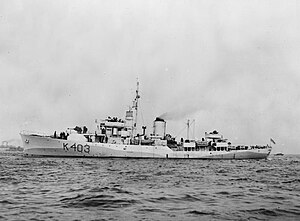HMNZS Arbutus (K403)

HMNZS Arbutus in July 1944
|
|
| History | |
|---|---|
|
|
|
| Builder: | George Brown and Company of Greenock, Scotland |
| Laid down: | 3 May 1943 |
| Launched: | 26 January 1944 |
| Commissioned: | 5 July 1944 |
| Decommissioned: | 1948 |
| Identification: | Pennant number: K403 |
| Fate: | Broken up June 1951 |
| General characteristics | |
| Class and type: | Flower-class corvette |
| Displacement: |
|
| Length: | 63.5 m (208 ft) o/a |
| Beam: | 10.1 m (33 ft) |
| Draught: | 5.3 m (17 ft) |
| Propulsion: | 2 fire tube oilers, one 4-cycle triple-expansion steam engine 2,880 ihp (2,130 kW) |
| Speed: | 16 knots (30 km/h) at 2,750 hp (2,050 kW) |
| Range: | 3,500 nautical miles (6,500 km) at 12 knots (22 km/h) |
| Complement: | 85 |
| Sensors and processing systems: |
ASDIC, radar (4×1-20mm) |
| Armament: |
|
HMNZS Arbutus was a modified Flower-class corvette of the Royal New Zealand Navy (RNZN). Built for the Royal Navy as HMS Arbutus, the corvette was transferred to the RNZN on completion in 1944, and operated during the final years of World War II. In April 1947, Arbutus was one of the units involved in a mutiny over poor pay and working conditions. She was decommissioned in 1948 and broken for scrap in 1951.
The corvette was built for the Royal Navy by George Brown and Company of Greenock, Scotland. She was laid down on 3 May 1943, and launched on 26 January 1944. Before completion, she was transferred to the Royal New Zealand Navy, and commissioned on 5 July 1944.
In early February, Arbutus was deployed on a two-month show the flag cruise around the Pacific Islands. The deployment had seen several incidents, the first of which occurred while the ship was docked in Tahiti; sailors who were meant to be guarding the ship became drunk, after which a crowd of Tahitians attempted to board the ship and remove equipment. On departure, the corvette sailed into a heavy storm, which lasted for several days. Waves breaking over the bow rendered the bridge unusable, and many aboard—including the ship's cat, for the first and only time in its life—were seasick. Water contamination of the fuel oil taken on in Tahiti damaged the propulsion machinery, further adding to the problems. When Arbutus finally limped into port at the end of March, the ship's company were informed that they would only remain at HMNZS Philomel long enough to take on aviation fuel and supplies to be delivered to the Cook Islands.
At the time of Arbutus' return to Philomel, there were problems affecting sailors across the RNZN. The main cause of unhappiness was a pay review due to be released in the next few days; the review was a year late, and sailors learned that they would still be underpaid in comparison to Army and Air Force equivalents, and that the government had backed down on its promise to backdate the pay to the original due date of the review. In addition, attempts to improve the working and living conditions aboard RNZN ships through lower-deck committees had proven to be ineffective.
...
Wikipedia
